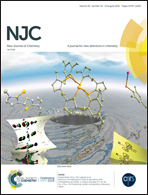Synthesis and electrochemical characterization of Mg–Al co-doped Li-rich Mn-based cathode materials
Abstract
Li-rich layered oxide cathodes suffer from poor rate capability, decayed voltage and inferior cycling stability. In this work, we propose a novel synergistic strategy to improve the electrochemical performance of Li-rich Li1.2Mn0.54Ni0.13Co0.13O2 by the co-doping of magnesium and aluminium. X-ray diffraction (XRD), Raman spectroscopy, scanning electron microscopy (SEM), energy dispersive spectrometry (EDS) mapping, X-ray photoelectron spectroscopy (XPS) measurements and electrochemical tests have been performed for analyzing and observing the characteristics and electrochemical properties of the as-prepared materials. The co-doping of Mg and Al materials delivers a larger initial reversible capacity of 271.9 mA h g−1, an improved cycling stability with 81.61% capacity retention after 100 cycles and an excellent rate capability of 119.8 mA h g−1 at 5C. These significant improvements in electrochemical performances are possibly ascribed to the fact that tiny amounts of Mg and Al ions doped into the transition-metal layer help to enlarge the lithium slab spacing, leading to a reduced barrier of Li+ during the intercalation–deintercalation process and enhanced rate capability. Meanwhile, the co-doping of Mg and Al not only inhibits the formation of oxygen vacancies, but also decreases cation mixing, which hinders the undesirable phase transformation from layered to spinel-like phases during cycling.



 Please wait while we load your content...
Please wait while we load your content...